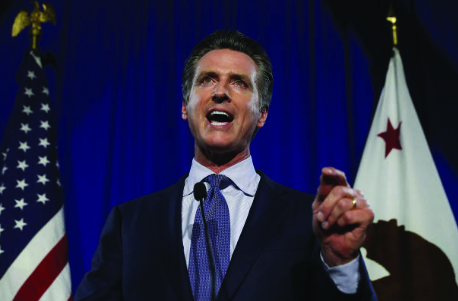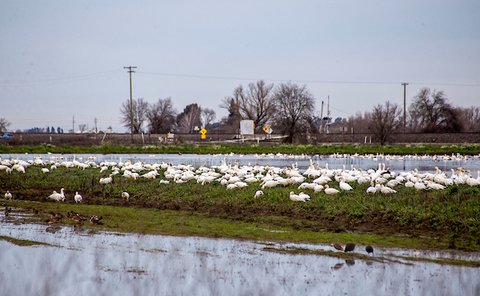
24 Apr Even Harder Than Shutting Down: How Does Newsom Reopen California?

By Laurel Rosenhall, CalMatters
Restless Californians are letting Gov. Gavin Newsom know they’re over his statewide order to stay home to prevent the spread of the coronavirus. At noisy street demonstrations and in polite letters from government officials, they’re saying: Let us start getting back to normal.
Other local leaders — still concerned about the potential for the virus to sicken or kill many more people — are urging the opposite, and Newsom said he’s heard from plenty of them, too: “The vast majority of calls are to caution us from taking the parachute off before we land.”
The dueling messages reflect the tug-of-war the governor likely will have to navigate for many months to come, as California gradually reopens society amid a pandemic that has killed nearly 48,000 Americans, upended every aspect of normal life and left more than 3 million Californians unemployed. Newsom will face competing pressures from government officials below and above him — U.S. Attorney General William Barr has said the federal government may join lawsuits against states with stringent stay-at-home orders — as well as business leaders, health experts and voters.
Those pressures, combined with the pandemic’s deadly threat, mean the governor will have to make a series of decisions far more difficult than the one he made March 19 when he issued a statewide order to stay home.
“That decision was a difficult one, but once it was made the actions were pretty clear: stay inside as much as you can… and prepare the hospitals,” said Jeffrey Martin, an epidemiologist at University of California, San Francisco.
“Now, on trying to get back to normal, you don’t have to act quickly, you have time to make a thoughtful decision, but the decision is harder. How much relaxation should you do? … How much can we go back to and how do we know when we’re ready? And how will we know when we’re not doing well at it?”
Newsom has repeatedly said that reopening will be more like adjusting a dimmer than flipping a light switch, and that he’ll be guided not by a target date, but by progress on six measurements, including the availability of tests to detect the virus and the ability for schools and businesses to assure greater distance between people.
“There is no such thing as reopening back to normal,” he said. “It’s normal with caveats, it’s reopening with conditions.”
Legislators and local officials from rural parts of the state are pushing the idea that reopening decisions should be made independently for each region. In a letter to Newsom, officials from the Central Coast have said businesses in their communities should be allowed to reopen because they have few infections and plenty of capacity at their hospitals. The Republican leader of the state Senate also asked Newsom to give cities and counties more authority to decide which businesses may reopen, an idea echoed by a GOP lawmaker from California’s remote far north.
Newsom signaled willingness to take a regional approach to reopening, but stopped short of announcing a plan to do it that way, as New York has already done.
“This is not a Republican virus or a Democratic virus. It’s not a rural virus or an urban virus,” said Newsom, a Democrat. “This knows no geography. It’s impacting every part of the state of California, not just large coastal cities.”
The health and economic impacts of the virus are weighing heavily on Californians, a recent poll shows, with 78% of adults worried that they or their family will get sick, and three-quarters of adults worried the pandemic will be bad for their personal finances.
“You’ve got this tension around what are people more worried about when they are very worried about both things,” said Mark Baldassare, president of the Public Policy Institute of California, which did the poll. “That’s a challenge for leadership right now.”
Newsom put together a large council to advise him on the state’s economic recovery. It includes leaders from business and labor, as well as all four living former California governors — Republicans Arnold Schwarzenegger and Pete Wilson, and Democrats Jerry Brown and Gray Davis.
“People’s urge to return to work is both normal and a blessing,” Davis said in an interview.
“And instead of resisting that, we’ve got to find ways that people can return to work safely, fairly, without leaving anyone behind.”
But California’s not there yet, he said, adding that the state can’t contemplate a large-scale return of the workforce until a lot more people are being tested for the virus, and schools reopen.
“So now you’re looking at August,” he said. “We have to do an awful lot of work between now and August.”
Davis said that timeline is his own opinion, not an official recommendation by the task force, but it likely will be unsatisfactory to many businesses that have been shuttered by the pandemic and are eager to start serving customers.
“We need to get people back in their jobs,” said Rob Lapsley, president of the California Business Roundtable, an association of the state’s largest corporations.
“There needs to be best practices formulated from this group right now,” he said of the governor’s new council, so businesses can adjust to new guidelines and start reopening in the next few weeks.
Businesses are worried about the potential for being sued over new conditions imposed by the pandemic — everything from labor laws that didn’t anticipate work-at-home employment, to liability if workers get sick on the job. They’ve asked Newsom to issue an executive order easing some labor laws and shielding them from some categories of litigation.
But in order to reopen, health experts say, the state needs to drastically ramp up the number of people that can be tested for infection and develop a massive new protocol of contact tracing. Both efforts are under way but remain far from the scale envisioned. Newsom said he is working toward a goal of testing about four times as many people as are now being tested — and has announced plans to develop a new “army” of workers who can trace the contacts sick people made before they were diagnosed.
Until then, health experts and health care workers say, Newsom shouldn’t make any drastic changes.
“We’re not comfortable about reopening,” said Stephanie Roberson, a lobbyist for the California Nurses Association. “We think it’s a little premature because the testing isn’t there.”
She pointed out that more than 4,100 California health care workers have been infected with COVID-19. Though the number of hospital patients with the illness has begun to plateau in the state, the number of people who died from the disease in a 24-hour period was larger Thursday than on any day since the pandemic began.
The life-and-death consequences should be Newsom’s guiding force, said Martin, the epidemiologist.
“You can resurrect an economy. You can’t resurrect dead bodies,” he said. “This is the defining moment of leadership, making difficult decisions in the face of criticism.”
CalMatters.org is a nonprofit, nonpartisan media venture explaining California policies and politics.






No Comments